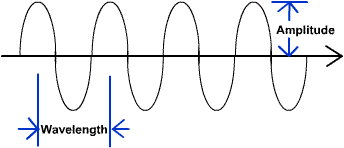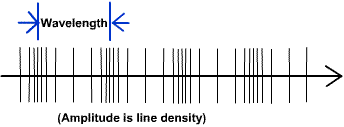|
Sound is a series of compression waves
that moves through air or other materials. These sound
waves are created by the vibration of some object, like
a radio loudspeaker. The waves are detected when they
cause a detector to vibrate. Your eardrum vibrates from
sound waves to allow you to sense them. Sound has the
standard characteristics of any waveform.
Questions you may have about sound are:
Sound is a waveform that travels through
matter. Although it is commonly associated in air, sound
will readily travel through many materials such as water
and steel. Some insulating materials absorb much of the
sound waves, preventing the waves from penetrating the
material.
Because sound is the vibration of
matter, it does not travel through a vacuum or in outer
space. When you see movies or TV shows about battles in
outer space, you should only be able to see an explosion
but not hear it. The sounds are added for dramatic
effect.
Note that in outer space, there are
actually some widely-spaced atoms and molecules floating
around. But since they are so far apart, regular wave
motion would not be great enough to detect.
Also note that light and radio waves are
electromagnetic waves. They are completely different
than sound, which is vibration of matter.
Electromagnetic waves are related to electrical and
magnetic fields and readily travel through space.
The back-and-forth vibration of an
object creates the compression waves of sound. The
motions of a loudspeaker cone, drumhead and guitar
string are good examples of vibration that cause
compression waves. This is different than the up and
down or transverse motion of a water wave.

Transverse Wave (water wave)

Compression Wave (sound)
The illustration above shows a
comparison of a transverse wave such as a water wave and
the compression wave sound wave.
Characteristics of sound
A sound wave has characteristics just
like any other type of wave, including amplitude,
velocity, wavelength and frequency.
The amplitude of a sound wave is the
same thing as its loudness. Since sound is a compression
wave, its loudness or amplitude would correspond to how
much the wave is compressed. It is sometimes called
pressure amplitude.
A common measurement of loudness is the
decibel (dB). It is really 1/10 of a bel, which was
named after the inventor of the telephone, Alexander
Graham Bell. It is a complex unit that varies as the
ratio of the logarithms of loudness.
A sound wave will spread out after it
leaves its source, decreasing its amplitude or loudness.
The amplitude decreases as the square of the distance
from the source. Also, if there is some absorption in
the material, the loudness of the sound will decrease as
it moves through the substance.
The speed or velocity of sound in air is
approximately 344 meters/second, 1130 feet/sec. or 770
miles per hour at room temperature of 20oC (70oF). The
speed varies with the temperature of air, such that
sound travels slower at higher altitudes or on cold
days.
Note: The difference between speed and
velocity is that velocity usually includes direction the
of travel. We'll interchange them here, but in some
cases the distinction is important.
A jet plane traveling at the speed of
sound would be moving at about 680 mph at sea level. At
very high altitudes, the speed required would be much
lower.
Wavelength is the distance from one
crest to another of a wave. Since sound is a compression
wave, the wavelength is the distance between maximum
compressions.
The frequency of sound is the rate at
which the waves pass a given point. It is also the rate
at which a guitar string or a loud speaker vibrates.
Frequency is also called the pitch of a sound. It is
called the note in musical sounds.
The relationship between velocity,
wavelength and frequency is:
velocity = wavelength x frequency
Since the velocity of sound is
approximately the same for all wavelengths, frequency is
often used to better describe the effects of the
different wavelengths.
The pitch or note of a sound that we
experience is determined by its wavelength or its
frequency. The shorter the wavelength, the higher the
frequency becomes, and the higher the pitch that we
hear.
Creating and detecting sounds
Creating and detecting sounds are
similar effects, but opposite. They demonstrate the
duality of nature.
Whenever an object in air vibrates, it
causes compression waves in the air. These waves move
away from the object as sound. There are many forms of
the vibration, some not so obvious.
The back and forth movement of a
loudspeaker cone, guitar string or drum head result in
compression waves of sound. When you speak, your vocal
cords also vibrate, creating sound.
Blowing across a bottle top can also
create sound. In this case, the air inside the bottle
goes in a circular motion, resulting in sound waves
being formed. Wind blowing through trees can also create
sound this indirect way.
Sound can also be created by vibrating
an object in a liquid such as water or in a solid such
as iron. A train rolling on a steel railroad track will
create a sound wave that travels through the tracks.
They will then vibrate, creating sound in air that you
can hear, while the train may be a great distance away.
When a sound wave strikes an object, it
can cause the object to vibrate. This leads to the
method to detect sound, which requires changing that
vibration into some other type of signal--usually
electrical.
The main way you detect or sense sounds
is through your ears. The sound waves vibrate your ear
drum, which goes to the inner ear and is changed to
nerve signals you can sense.
You can also feel sounds. Stand in front
of a stereo or hi-fi loudspeaker on at full volume, and
you can feel some of the vibrations from the music.
There are mechanical devices that detect
sounds, such as the microphone. The sound vibrates a
membrane, which creates an electric signal that is
amplified and recorded.
Sound is a compression waveform created
by the vibration of some object. Sound moves through air
or other materials. The characteristics of sound are
that it has amplitude, wavelength, frequency and
velocity. Sound must cause another object to vibrate to
be detected. |